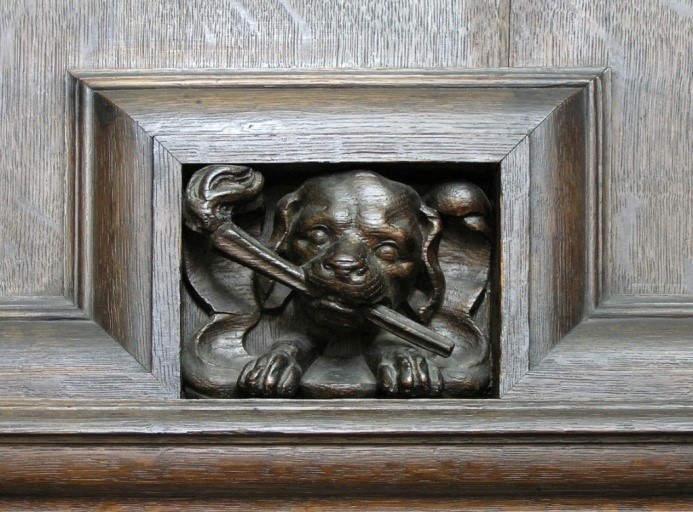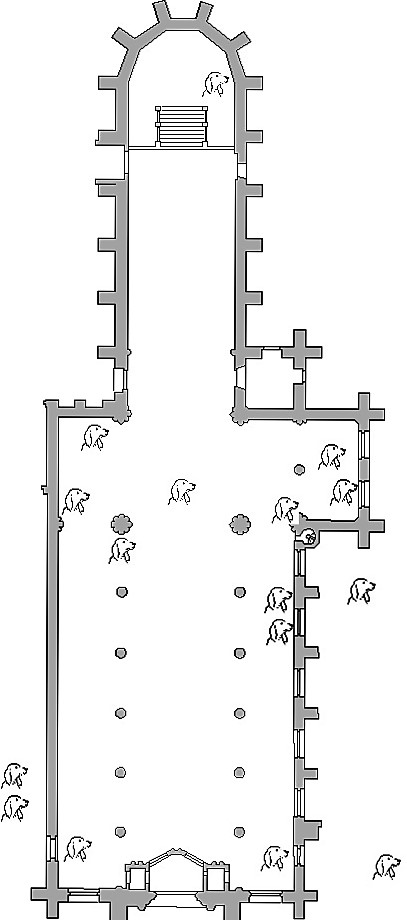Saint Paul’s, the Antwerp Dominican church, a revelation
Saint Dominic, the founder of the order,
and the Dominican Order
Dominic’s identity card
| born: | between 1171 and 1173 in Claruega, in the bishopric of Osma (Castile, Spain). |
| parents: | Felix de Guzmán and Juana de Aza. |
| name: | de Guzmán, as a canonSomeone who, together with other canons, is attached to a cathedral or collegiate church and whose main task is to ensure choral prayer. also ‘de Osma’, after his official residence. |
| first name: | Domenico (‘of the Lord’; Latin: ‘Dominicus’). |
| education: | since the age of 14 higher education in arts, discussion, theology and Biblical studies in Palencia. |
| social position: | nobleman by birth, since 1196 canon in Osma, ordained a priestIn the Roman Catholic Church, the priest is an unmarried man ordained as a priest by the bishop, which gives him the right to administer the six other sacraments: baptism, confirmation, confession, Eucharist, marriage, and the anointing of the sick. |
| voyages: | When he returned from Rome with his bishopPriest in charge of a diocese. See also ‘archbishop’., he helped the latter to convert the Albigensians in the south of France. After his bishop’s death in 1207 this remained his most important mission. |
| founder: | In 1215 he founded the order of Preachers (predicatores), from the insight that heretical movements flourish due to lack of popular education and pastors. |
| writings: | strangely enough none has been preserved, with the exception of a few letters. |
| death: | 6th August 1221 in Bologna, where his relics rest. |
| canonisation: | 1234 |
| Saint’s day: | Because the day of Dominic’s death was the feast of Jesus’ transfiguration on Mount Tabor, before Vatican II he was celebrated on 4th August; now he is on 8th August. The EpistleIn Mass, the Bible reading(s) preceding the gospel reading. According to the lectionary, there are always three readings on Sundays: one from the Old Testament, one from the non-gospel texts of the New Testament and one from a gospel. The first two readings are often called the epistle but strictly this word refers only to the letters of St Paul and other apostles. of that day is a passage from Paul’s Second Epistle to Timothy (4:1-8) about the true gospelOne of the four books of the Bible that focus on Jesus’s actions and sayings, his death and resurrection. The four evangelists are Matthew, Mark, Luke, and John. ‘Gospel’ is the Old English translation of the Greek evangeleon, which literally means ‘Good News’. This term refers to the core message of these books.. |
| apostolic mission: | According to the legend Paul appeared to him in a vision and gave him this commission: “Preach the word of God, Dominic, for this task I have elected you”. On his voyages Dominic carried the Gospel according to SaintThis is a title that the Church bestows on a deceased person who has lived a particularly righteous and faithful life. In the Roman Catholic and Orthodox Church, saints may be venerated (not worshipped). Several saints are also martyrs. Matthew and the Epistles of Saint PaulOriginally, he was called Saul, he was a Jew with Roman citizenship and a persecutor of Christians in the period shortly after the death of Jesus. After his conversion, he became the main gospel spreader in what is now Turkey and Greece. He wrote letters to keep in touch with the Christian communities he had founded, and these texts are the oldest ones in the New Testament. Although he never met Jesus, he is called an “apostle”.. |

| AS | BY |
| a clergyman: | the tonsure of clerical status. |
| a Dominican: | the white habitGeneral name for the typical clothing of a particular religious order. A long-sleeved, unbuttoned robe down to the feet, usually with a hood attached. This attire is typical of monks and nuns. and the black cloak of the Dominican order. |
| a teacher: | a book, which refers to his theological formation and teaching; hence not specifically the Bible. |
| a proclaimer of the faith: | the (legendary) torch dog and the globe. Shortly before the birth of her son Dominic’s mother Aza dreamt that she would give life to a small dog bearing a torch in its mouth with which it would put the entire world ablaze. Due to this legend the (later black and white spotted) dog has become one of the most important attributes of Saint Dominic. How popular the torch dog as Dominic’s attribute is, is shown from the fact that in the part of the Antwerp Dominican church that is open to the public the dog accompanies the founder of the order no less than 16 times. There even used to be dogs on the tower.. |
| founder of the order: | the constitution book of the order. |
| star on his front: | According to the legend, when lifting him from the baptismal fontThe stone or metal vessel containing holy water, used for administering baptism. Often the baptismal font is/was located in a specially designed baptistery, usually close to the entrance of the church., his godmother saw a brilliant star on small Dominic’s front lending lustre to the entire world. |
| chaste: | a lily. In the alleluia verse of his saint’s day the reference to the Messiah (Hosea 14) can also be applied to Dominic: “he shall blossom like the lily; He shall strike root like the Lebanon cedar.” |
| penance: | a scourge, sometimes a chain and a stone. |
| worshipper of Mary: | Dominic receives the rosary out of Our Lady’s hands: an image cherry picked by the Dominicans to promote devotion to the rosary. |
The Dominican Order
| name: | The Order of the Preachers, which was approved of by Pope Honorius III in his bull in 1216: Ordo Predicatorum, abbreviated as ‘o.p.’. Initially they were commonly called ‘Preachers’. Because most of them were priests, later they were generally called ‘predikheren’ (‘Friars Preachers’) in the Low Countries. |
| surname: | Only after Dominic’s death the Friars PreacherA priest, deacon or lay person who explains the Bible readings during the celebration of Mass. Sometimes a preacher also acts outside of Mass celebrations (and in the past he did so regularly) to clarify certain points of faith and to encourage the churchgoers to a more Christian way of life. were also called Dominicans, after their founder. The surname ‘Jacobins’ refers to the Dominican conventComplex of buildings in which members of a religious order live together. They follow the rule of their founder. The oldest monastic orders are the Carthusians, Dominicans, Franciscans, and Augustinians [and their female counterparts]. Note: Benedictines, Premonstratensians, and Cistercians [and their female counterparts] live in abbeys; Jesuits in houses. in Paris, named after the already existing chapel |
| motto: | ‘Veritas’ (truth). |
| device: | ‘Laudare, benedicere, praedicare’ (praising, blessing, preaching) typifies the order, which concentrates on prayer, administration of sacraments and preaching. |
| blazon: | The eight pointed star is black and white due to the colours of the habit. In the middle of it there is a dog with a burning torch in its mouth. |
| habit: | Inside the convent the Dominican wears a white habit, outside he wears a black cloak over it. |
| reputation: | Since the mission of the Dominicans was to defend Catholic faith against heresy, the Dominicans were the leaders of Inquisition (‘Investigation’). |
| 3 orders: | first order: brothers, to be distinguished into priests (‘friars) and lay brothers second order: women monastics (contemplative nuns). third order: the lay order, groups of both men and women that depend on a convent of the first order. Famous members were Catharina of Siena and Rosa of Lima; in those days however they did wear the sisters’ habit. |




